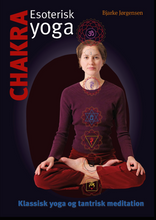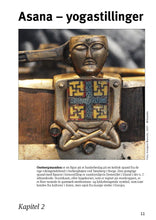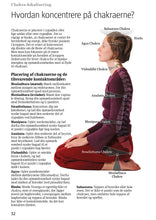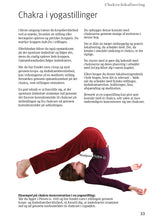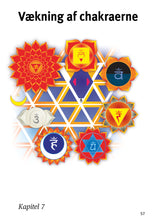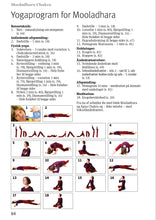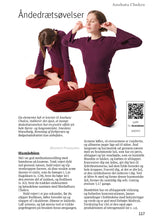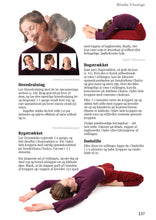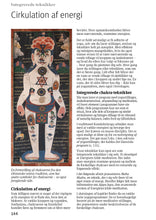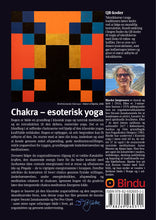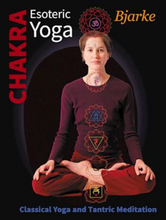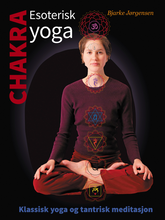
Chakra - Esoteric Yoga, by Bjarke Jørgensen
The book serves both as an introductory guide to Classical Yoga and Tantric meditation, as well as a deeper dive into esoteric yoga. It is a guide for exploring the chakras using powerful tools from classical yoga. The book is structured so that even beginners can benefit from it. It begins with exercises to help you connect with your body, breath, and mind through simple relaxation, comfortable meditation postures, basic yoga exercises for the back, fundamental breathing techniques, and meditations. From there, you follow the yogic approach to awaken the Kundalini energy, the dormant force within. Additionally, it develops your connection to each chakra through physical poses, breathing techniques, other energy techniques, relaxation, and meditation specific to each chakra.
Yoga techniques are best learned with verbal guidance. Throughout the book, you'll find QR codes linking to videos and audio files for some of the techniques. With over seven hours of instruction, these resources make learning easier and more fruitful.
The book is available in Danish (paperback), easily understood Norwegian (hardcover), and English (hardcover).
About the Author
Bjarke Jørgensen, born in Denmark in 1954, began his yoga teacher training in 1976 under Swami Janakananda, seeking to combine an active, creative life with spiritual qualities. After seven years of intense Sadhana and Ashram life in Copenhagen, Aarhus, and Oslo, he founded the Yoga School in Bergen, Norway, in 1983. Jørgensen has taught classical yoga for over 40 years and, for the past 34 years, also advanced tantric meditations such as Antar Mauna and Ajapa Japa. He also applies his creativity in painting, web design, desktop publishing, and building traditional Norwegian log houses. He resides at Ask Course Center with Audhild and enjoys mountain hiking in Norway and abroad.
Review of the Book "Chakra - Esoteric Yoga"
_"The closest you’ll get to a book that can teach you to immerse yourself in yoga, regardless of your starting point"_
By Audun Myskja - Author, Chief Physician, and Specialist in General Medicine
The author is one of the most experienced and consistent teachers in Norway's rapidly growing yoga movement. I personally attended one of the first yoga courses in Norway in 1976, led by Peo, one of the mentors who contributed to this work. Over the years, I have witnessed yoga emerge as perhaps the most complete package we have for building spiritual, mental, and physical health. The fact that an ancient discipline has so much to offer modern individuals says something about the enduring wisdom of this tradition. The author upholds this tradition with a depth of experience that few others can match, presenting an authoritative work centered on the chakra system.
Jørgensen begins by clarifying that chakras are not fixed entities like a femur bone. The fascinating thing about chakras, which makes them so useful in inner work, is that they lie at an intriguing intersection between subjective and objective, subtle and concrete—acting as a gateway or bridge. This is the primary reason I have prioritized chakra work and taught this tradition for decades: chakras are like music, offering a meeting point between different dimensions. At the same time, the study of chakras challenges all absolute traditions, such as our materialistic science. Working with chakras yields consistent experiential results because they can unify the fragmented aspects of our turbulent age.
Having read many books on yoga and chakras in Scandinavian, English, and German, I find this book to be a significant contribution to a field overflowing with chakra books that often simplify the subject to the point of making it dull and abstract.
Jørgensen's style is consistent and authoritative. Having tried to explain exercises in books myself, I know how challenging it is to keep them clear and simple. I have never read a yoga book that presents various exercises as clearly, without oversimplifying. At the same time, the depth of the experience is palpable, instilling confidence and motivation to practice. This book comes closest to teaching immersion in yoga, regardless of one’s starting point. Jørgensen also stresses that the depth can scarcely be learned from books alone, which is why he generously provides a well-structured digital learning resource tailored to the book’s framework. The thoroughness behind this publication is evident!
When it comes to esoteric traditions, the book handles these with the same strength. The author manages to make these traditions accessible without trivializing them, presenting profound teachings in an approachable way. As someone who has studied chakra work deeply for decades, I find many simplified chakra books frustrating: in attempting to modernize a deep tradition, authors often present schematics that violate the tradition and lack empirical grounding. Reading Jørgensen’s lived-in descriptions of the chakras adds new dimensions to my understanding—something I’ve missed in recent literature. Each sentence in these chapters is precise and thorough: material that can be tested and built upon to form an understanding of chakras as a unique entryway into how spirit, mind, and body are interconnected. For those struggling in today's world, this book provides an invaluable tool. Jørgensen avoids clichés and frivolity, using refined language that enables access to spirit, body, and subconscious in a way I’ve only previously found in classical yogic texts. Meanwhile, the content is updated and accessible to scientific thinking. The chakra section is especially innovative and unique.
If I were to point out something missing in this book, it would be the same as in most other yoga books:
- Case studies offering a clearer picture of yoga in daily life.
- Guidance on overcoming obstacles and what one achieves over time.
- Instructions for adapting to different levels of ability.
I am convinced that our time calls us to reconnect with our roots—not to cling to traditions, but to respect their sources. In this effort, Bjarke Jørgensen has done a remarkable job presenting a tradition in a clear and simple way, incorporating his own experiences to make the tradition vibrant and relevant for our time. This book is a work of art, requiring deep experience and the artist’s creative skill to bring it to life. Bjarke Jørgensen has written a book of lasting value.
About Audun Myskja (b. 1953)
Chief physician and specialist in general medicine with a doctorate in the use of music in elder care, Myskja and his wife, Reidun, run the Center for Life Assistance in Totenvika, focusing on mastery medicine—tools for health and growth. He is the author of several best-selling books, including *Find Your Inner Strength*, *The Fountain of Youth*, *Breathe*, *The Art of Finding Peace*, and *The Tibetan Rituals - 15 Minutes that Transform Your Life*. Myskja has developed the studies in Music-Based Environmental Treatment and Unity Therapy mastery medicine, providing systematic frameworks for strengthening resilience and resource-based approaches to unresolved challenges in healthcare and society. An accomplished speaker, he has led numerous national projects to improve quality in health and care. As a musician, he has released several albums of his own songs and music with relaxation instructions. Myskja has been a meditation teacher since the 1980s and has led a meditation teacher training program at the Center for Life Assistance since 2021.
The book serves both as an introductory guide to Classical Yoga and Tantric meditation, as well as a deeper dive into esoteric yoga. It is a guide for exploring the chakras using powerful tools from classical yoga. The book is structured so that even beginners can benefit from it. It begins with exercises to help you connect with your body, breath, and mind through simple relaxation, comfortable meditation postures, basic yoga exercises for the back, fundamental breathing techniques, and meditations. From there, you follow the yogic approach to awaken the Kundalini energy, the dormant force within. Additionally, it develops your connection to each chakra through physical poses, breathing techniques, other energy techniques, relaxation, and meditation specific to each chakra.
Yoga techniques are best learned with verbal guidance. Throughout the book, you'll find QR codes linking to videos and audio files for some of the techniques. With over seven hours of instruction, these resources make learning easier and more fruitful.
The book is available in Danish (paperback), easily understood Norwegian (hardcover), and English (hardcover).
About the Author
Bjarke Jørgensen, born in Denmark in 1954, began his yoga teacher training in 1976 under Swami Janakananda, seeking to combine an active, creative life with spiritual qualities. After seven years of intense Sadhana and Ashram life in Copenhagen, Aarhus, and Oslo, he founded the Yoga School in Bergen, Norway, in 1983. Jørgensen has taught classical yoga for over 40 years and, for the past 34 years, also advanced tantric meditations such as Antar Mauna and Ajapa Japa. He also applies his creativity in painting, web design, desktop publishing, and building traditional Norwegian log houses. He resides at Ask Course Center with Audhild and enjoys mountain hiking in Norway and abroad.
Review of the Book "Chakra - Esoteric Yoga"
_"The closest you’ll get to a book that can teach you to immerse yourself in yoga, regardless of your starting point"_
By Audun Myskja - Author, Chief Physician, and Specialist in General Medicine
The author is one of the most experienced and consistent teachers in Norway's rapidly growing yoga movement. I personally attended one of the first yoga courses in Norway in 1976, led by Peo, one of the mentors who contributed to this work. Over the years, I have witnessed yoga emerge as perhaps the most complete package we have for building spiritual, mental, and physical health. The fact that an ancient discipline has so much to offer modern individuals says something about the enduring wisdom of this tradition. The author upholds this tradition with a depth of experience that few others can match, presenting an authoritative work centered on the chakra system.
Jørgensen begins by clarifying that chakras are not fixed entities like a femur bone. The fascinating thing about chakras, which makes them so useful in inner work, is that they lie at an intriguing intersection between subjective and objective, subtle and concrete—acting as a gateway or bridge. This is the primary reason I have prioritized chakra work and taught this tradition for decades: chakras are like music, offering a meeting point between different dimensions. At the same time, the study of chakras challenges all absolute traditions, such as our materialistic science. Working with chakras yields consistent experiential results because they can unify the fragmented aspects of our turbulent age.
Having read many books on yoga and chakras in Scandinavian, English, and German, I find this book to be a significant contribution to a field overflowing with chakra books that often simplify the subject to the point of making it dull and abstract.
Jørgensen's style is consistent and authoritative. Having tried to explain exercises in books myself, I know how challenging it is to keep them clear and simple. I have never read a yoga book that presents various exercises as clearly, without oversimplifying. At the same time, the depth of the experience is palpable, instilling confidence and motivation to practice. This book comes closest to teaching immersion in yoga, regardless of one’s starting point. Jørgensen also stresses that the depth can scarcely be learned from books alone, which is why he generously provides a well-structured digital learning resource tailored to the book’s framework. The thoroughness behind this publication is evident!
When it comes to esoteric traditions, the book handles these with the same strength. The author manages to make these traditions accessible without trivializing them, presenting profound teachings in an approachable way. As someone who has studied chakra work deeply for decades, I find many simplified chakra books frustrating: in attempting to modernize a deep tradition, authors often present schematics that violate the tradition and lack empirical grounding. Reading Jørgensen’s lived-in descriptions of the chakras adds new dimensions to my understanding—something I’ve missed in recent literature. Each sentence in these chapters is precise and thorough: material that can be tested and built upon to form an understanding of chakras as a unique entryway into how spirit, mind, and body are interconnected. For those struggling in today's world, this book provides an invaluable tool. Jørgensen avoids clichés and frivolity, using refined language that enables access to spirit, body, and subconscious in a way I’ve only previously found in classical yogic texts. Meanwhile, the content is updated and accessible to scientific thinking. The chakra section is especially innovative and unique.
If I were to point out something missing in this book, it would be the same as in most other yoga books:
- Case studies offering a clearer picture of yoga in daily life.
- Guidance on overcoming obstacles and what one achieves over time.
- Instructions for adapting to different levels of ability.
I am convinced that our time calls us to reconnect with our roots—not to cling to traditions, but to respect their sources. In this effort, Bjarke Jørgensen has done a remarkable job presenting a tradition in a clear and simple way, incorporating his own experiences to make the tradition vibrant and relevant for our time. This book is a work of art, requiring deep experience and the artist’s creative skill to bring it to life. Bjarke Jørgensen has written a book of lasting value.
About Audun Myskja (b. 1953)
Chief physician and specialist in general medicine with a doctorate in the use of music in elder care, Myskja and his wife, Reidun, run the Center for Life Assistance in Totenvika, focusing on mastery medicine—tools for health and growth. He is the author of several best-selling books, including *Find Your Inner Strength*, *The Fountain of Youth*, *Breathe*, *The Art of Finding Peace*, and *The Tibetan Rituals - 15 Minutes that Transform Your Life*. Myskja has developed the studies in Music-Based Environmental Treatment and Unity Therapy mastery medicine, providing systematic frameworks for strengthening resilience and resource-based approaches to unresolved challenges in healthcare and society. An accomplished speaker, he has led numerous national projects to improve quality in health and care. As a musician, he has released several albums of his own songs and music with relaxation instructions. Myskja has been a meditation teacher since the 1980s and has led a meditation teacher training program at the Center for Life Assistance since 2021.












